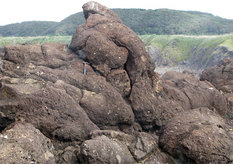地質調査研究報告 トップへ
地質調査研究報告 Vol.59 No.5/6 (2008)
表紙

男鹿半島、かぶき岩の枕状溶岩
かんらん石玄武岩質安山岩からなるこの枕状溶岩は、後期始新世のある時期に浅い水底に定置したと考えられている。枕状ローブは垂れ下がり、その表面には伸長方向に沿った割れ目と横断する方向に割れ目が発達している。枕状ローブの表面は風化して細かな構造は見えないが、断面では放射状節理がところどころ認められる。ローブの一部にはパホイホイ溶岩に特徴的な縄状のしわが認められる。かぶき岩周辺には、この枕状溶岩のほかに、陸上定置のスパターやアア溶岩も分布しており、当時のかぶき岩は水陸境界付近にあったといえよう。
(写真と文 : 鹿野和彦)
目次
| タイトル | 著者 | |
|---|---|---|
| 論文 | ||
| 御岳火山の歴史噴火記録の再検討と噴気活動の歴史記録 ─存在しなかった774、1892 年噴火─ | 及川輝樹 (203-210) | 59_05_01.pdf [1.1 MB] |
| 東北日本、男鹿半島門前層層序の再検討 | 小林紀彦・ |
59_05_02.pdf [2.2 MB] |
| Chemical compositions of the Paleogene granitoids of eastern Shimane Prefecture, Sanin District, Southwest Japan | Shunso Ishihara and Bruce W. Chappell (225-254) | 59_05_03.pdf [4.8 MB] |
| Late Eocene shoreline volcanism along the continental margin: the volcanic succession at Kabuki Iwa, Oga Peninsula, NE Japan | Takeshi Ohguchi, Hiromitsu Yamagishi, Norihiko Kobayashi and Kazuhiko Kano (255-266) | 59_05_04.pdf [2.4 MB] |
| 概報 | ||
| 下北半島北部に分布する田名部D テフラのジルコン・フィッション・トラック年代 | 桑原拓一郎 |
59_05_05.pdf [1.1 MB] |
| 資料・解説 | ||
| 溶存成分組成から見た山地の水循環における水質変化 ─新潟・山形県境金丸地域の例─ | 奥澤康一・ |
59_05_06.pdf [18.7 MB] |
要旨集
御岳火山の歴史噴火記録の再検討と噴気活動の歴史記録 ─存在しなかった774、1892 年噴火─
及川輝樹
御岳火山の歴史時代の噴火記録として西暦774及び1892年の記録の存在が指摘されていたが、典拠とされていた文献を再調査した結果、それら噴火は存在しないことが明らかとなった。18 世紀末からの宗教登山の活発化を考慮すると、18 世紀末から 1979 年噴火までの間、噴火はなかった可能性が高い。史料に基づくと御嶽山山頂部の地獄谷において少なくとも 18 世紀半ばより噴気活動が継続していたが、1979 年噴火の後、地獄谷の他に八丁タルミにおいても噴気活動が起こるようになった。また、1991、2007 年には八丁タルミの噴気孔から小規模な火山灰放出 (微噴火) が起きている。そのため、1979 年噴火以降の御岳火山の火山活動は、最近の250年間において最も活発であると考えられる。
東北日本、男鹿半島門前層層序の再検討
小林紀彦・大口健志・鹿野和彦
門前層は男鹿市門前から赤島に至る海岸を模式地とし、赤島層の上位にあって野村川層もしくは台島層に覆われる火山岩主体の地層として位置づけられる。下位の赤島層とは断層で接し、上位の野村川層・台島層とは不整合関係にある。地表に露出する門前層は、火山岩の岩相の組み合わせとそれらの空間的広がりから互いに識別し得る地質単元として、下位から順に舞台島玄武岩、竜ヶ島デイサイト、長楽寺砂礫岩、長楽寺玄武岩、長崎デイサイト、毛無山安山岩、真山流紋岩に区分できる。そのうち、長楽寺砂礫岩と長楽寺玄武岩は一部指交関係にある。これらの主体をなす火山岩は、沈降しつつある水域または水域に面した陸上に 34〜36 Ma の範囲内の極めて短時間に噴出し、互いに重なり合ういくつかの火山体を形成した。門前層から読み取れるこのような地質過程は、日本海拡大の前触れとも考えられる。しかし、門前層と上位の台島層との間に一千万年を超える時間間隙が存在しており、22〜20 Ma 以降活発になる日本海拡大との関係については更に地域を広げて検討する必要がある。
Chemical compositions of the Paleogene granitoids of eastern Shimane Prefecture, Sanin District, Southwest Japan
Shunso Ishihara and Bruce W. Chappell
Magnetite-series Paleogene granitoids of Mo-mineralized region of eastern Shimane Prefecture were studied chemically and compared with ilmenite-series granitoids of the Ryoke belt of the Chubu district. The eastern Shimane granitoids are divided into coarse-grained granodiorite and granite of batholithic bodies, and fine-grained granitoids occurring close to the roof-pendant. The fine-grained ones, varying in composition from quartz diorite to aplite are further subdivided into: Zakka and Kawai types, Rengeji type, leucogranites in the ore horizon, Yamasa type, Shimokuno type, and Ouchidani type. These granitoids are poor in A/CNK, Ga, Ga x 10000/A, K2O, Rb, Ba, Pb, CaO, Fe2O3, Zn, Y, La and Ce, and rich in Na2O, MgO, V and U, as compared with those of the Ryoke granitoids in the Chubu district. The chemical data indicate that the eastern Shimane granitoids are originated in source rocks with poor continental components, such as Al2O3, K2O, REE, and organic carbon. Some gabbroids which are high in Sr content and Sr/Y ratio may have been derived from slab-melting. Rengeji Older Granite is potassic being K2O>Na2O, and rich in La, Ce, Y, Nb, Th, U; thus continental in the source rocks.
There occur small metamorphic bodies containing locally spinel and andalusite along the northwestern margin of the Rengeji Granodiorite. Kanenari hornfels is considered mainly psammitic with peraluminous layers. Togiishiyama hornfels has high A/CNK ratio but the K2O contents are normal as to the SiO2 contents. This rock contains rock-forming mineral of magnetite and has unusually high amounts of S, Cu, Pb, Zn and MnO. Therefore, the original rocks are considered intermediate to felsic tuffaceous sediments containing very little organic carbon. Mo-contents are high as 2.0 to 6.3 ppm Mo in average of the granitoids that host major molybdenite deposits, such as Kawai mingled rocks (Daito mine), Rengejileucogranites (Seikyu and Higashiyama mines) and Yamasa leucogranite (Yamasa mine). Therefore, trace amounts of Mo of fresh granitoids can be used as an exploration indicator.
Late Eocene shoreline volcanism along the continental margin: the volcanic succession at Kabuki Iwa, Oga Peninsula, NE Japan
Takeshi Ohguchi, Hiromitsu Yamagishi, Norihiko Kobayashi and Kazuhiko Kano
Kabuki Iwa (Rock) at the northwestern shore of Oga Peninsula is composed of Late Eocene basaltic andesite aa lava flows and pillowed lava flows, dacitic pyroclastic flows, debris flows and other epiclastic rocks. This close association of the subaerial and subaqueous volcanic products demonstrates a transitional environment between land and shallow water. NE-SW-trending parallel dikes and normal faults are also associated with these rocks in the surrounding areas, and the volcanic succession at Kabuki Iwa is interpreted to have accumulated in an extensional basin which slowly subsided with volcanism before the rapid opening of the Japan Sea.
出版物とサービス
- お知らせ(出版物)
- 地質図カタログ
- 購入案内
-
地質調査研究報告
- 2025年 (Vol.76)
- 2024年 (Vol.75)
- 2023年 (Vol.74)
- 2022年 (Vol.73)
- 2021年 (Vol.72)
- 2020年 (Vol.71)
- 2019年 (Vol.70)
- 2018年 (Vol.69)
- 2017年 (Vol.68)
- 2016年 (Vol.67)
- 2015年 (Vol.66)
- 2014年 (Vol.65)
- 2013年 (Vol.64)
- 2012年 (Vol.63)
- 2011年 (Vol.62)
- 2010年 (Vol.61)
- 2009年 (Vol.60)
- 2008年 (Vol.59)
- 2007年 (Vol.58)
- 2006年 (Vol.57)
- 2005年 (Vol.56)
- 2004年 (Vol.55)
- 2003年 (Vol.54)
- 2002年 (Vol.53)
- 2001年 (Vol.52)
- 活断層・古地震研究報告
- GSJ 地質ニュース
- CCOP-GSJ 地下水プロジェクトレポート
- GSJ技術資料集
- ビデオ・パンフレット・ポスター
- その他の出版物
